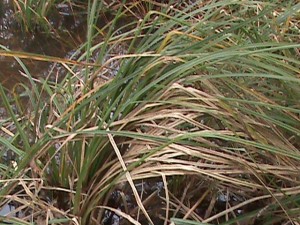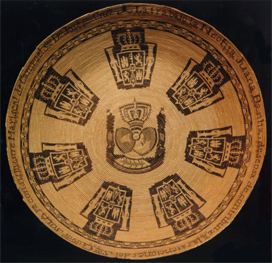‘Tis the season… for respiratory illnesses.
But don’t take antibiotics! In the long run they will weaken both your and your environment’s immune systems. There are about ten times more bacterial cells in your body than your own cells. You want to kill them all off with antibiotics and leave their habitat empty for takeover?! No; instead, take medicinal herbs, especially in hot teas, and eat healthily – lots of juices, fruits and veggies, and hot clear soups.
The following are herbs that the California Indians used to combat colds / flu / sore throats / bronchitis / fevers. They are all native to the California Bay Area, extending through Central and Northern California, but many of the same species or their relatives can be found across the US, both wild and in herb stores. I’ve tried to list them roughly in order of importance and availability.
Yerba santa (“holy herb,” Eriodictyon californicum) – an infusion or decoction of the leaves was drunk as an extensively used, very effective, and specific cure for colds, influenza, fevers, and stuffy / runny nose (Chesnut 1902, Moore 1993). This is probably the best herb for colds/flu; I made a strong infusion and noticed my discharges immediately drying up. I drank several cups of strong infusions with raw wildflower honey the evening I felt real bad and felt much better the following day, drank the same, and was cured by the third. I did, however, use many other of the below herbs, but I feel like most were temporarily relieving symptoms whereas yerba santa was curative.
Wormwood / mugwort / bronchitis plant (Artemisia spp.) – a decoction of leaves was drunk as a specific cure for colic and colds, was very efficacious for bronchitis, and fresh bruised leaves were placed in the nostrils to relieve the symptoms of colds (Chesnut 1902).
Angelica (Angelica spp.) – the roots, gathered when the plant’s leaves dry off in mid to late summer, were chewed and the juice swallowed for colds, fever, and sore throat, a decoction wash made of them for relief of colds, or they were crushed and smoked like tobacco for colds and stuffy / runny nose (Chesnut 1902, Goodrich et al. 1980). I chewed this and swallowed the juice and definitely had some relief; this would be a great relief for sore throat.
Coffeeberry (Rhamnus californica) – a decoction of the bark (a handful of bark per gallon of water was boiled until it tasted like wine) was a specific remedy for influenza (Chesnut 1902). I tried this but it was a little late to tell whether it helped. It was not so much like wine but about as bitter as red wine.
Madrone (Arbutus menziesii) – an infusion of leaves was drunk for colds by the Little Lake tribe (Chesnut 1902).
Manzanita (Arctostaphylos spp.) – an infusion of the leaves was used to cure severe colds by the Calpella tribe (Chesnut 1902).
California spikenard (Aralia californica S. Watson) – the roots, gathered July-August, were dried and a decoction made from these was highly valued as a cure for colds and fevers (Goodrich et al. 1980, Chesnut 1902).
California bay laurel (Umbellularia californica) – an infusion of the leaves was used for colds and sore throats. This is a strong antimicrobial but likely doesn’t cure a viral infection.
Pines and firs (Pinus spp. and Abies spp.) – an infusion or decoction of needles and/or sap were used to relieve and cure colds (Strike 1994). The resin or sap was also burned for incense to relieve sinus problems (Strike 1994).
Infusions or decoctions of redwood, red cedar, and other conifer needles or sap have similar antimicrobial and decongestant effects (Moore 1993). I drank a lot of redwood needle tea and ate pine sap to feel better.
Sweet coltsfoot (Petasites palmata Gray.) – roots were used for influenza (Chesnut 1902).
Balsam root (Balsamorhiza sagittata) – a decoction or tincture of the fresh root is a disinfectant-expectorant used for sore throat, bronchitis, and the flu (Moore 1993).
Lomatium (Lomatium dissectum) – a cold infusion or tincture of the fresh or dry root is a powerful antimicrobial that is used against respiratory virus infections such as influenza, bronchitis, and sore throats (Moore 1993).
Yarrow (Achillea millefolium) – a powerful medicine of many uses, yarrow is especially helpful for acute fevers that begin as a head cold or flu (Moore 1993). For this ailment, drink a hot infusion or tincture (of the whole plant or any of its parts) in hot water (Moore 1993).
Ciliate gilia (Linanthus ciliatus (Benth.) Greene.) – an infusion was used as a remedy for coughs and colds in children (Chesnut 1902).
Rosinwood (Grindelia sp.) – a decoction of the whole plant was used to cure colic and colds, especially in children (Chesnut 1902).
White horehound (Marrubium vulgare L.) – a decoction of leaves and stems was used to cure colds (Chesnut 1902).
Pepper vine (Clematis ligusticifolia Nutt.) – the stems were chewed to cure colds and sore throat (Chesnut 1902).
Bigflower Tellima (Tellima odorata) – roots were chewed to relieve colds (Chesnut 1902).
Dog fennel / fireweed (Anthemis cotula) – this plant has extremely irritating juices that cause a burning sensation, but the fresh plants were sometimes placed in bath water as a wash for severe colds (Chesnut 1902).
References:
Chesnut, V. K. 1902. Plants used by the Indians of Mendocino County, California. Government Printing Office, Washington, DC.
Goodrich, J., Lawson, C., and Lawson, V. P. 1980. Kashaya Pomo plants. American Indian Studies Center, University of California, Los Angeles, CA.
Moore, M. 1993. Medicinal plants of the Pacific West. Museum of New Mexico Press, Santa Fe, NM.
Strike, S. S. 1994. Ethnobotany of the California Indians; Vol. 2. Aboriginal uses of California’s indiginous plants. Koeltz Scientific Books USA, Champaign, IL.







